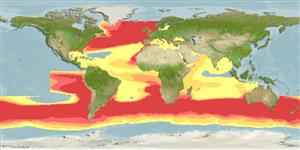Environment: milieu / climate zone / depth range / distribution range
Ecologia
marinhas; oceanódromo (Ref. 51243); intervalo de profundidade 0 - 1000 m (Ref. 4388), usually 0 - 200 m (Ref. 89422). Subtropical; 12°C - 24°C; 65°N - 70°S, 180°W - 180°E
Atlantic, Indian and South Pacific (Ref. 47377). Western Atlantic: Nova Scotia, Canada and Bermuda (Ref. 7251) to Belize and the Antilles (Ref. 26340). Also found in Brazil (Ref. 47377) and in Argentine (Ref. 2806). Eastern Atlantic: central Norway (Ref. 6697) southward to Algoa Bay, South Africa (Ref. 4388). Highly migratory species.
Tamanho / Peso / Idade
Maturity: Lm ? range ? - ? cm
Max length : 100.0 cm TL macho/indeterminado; (Ref. 26340); common length : 40.0 cm SL macho/indeterminado; (Ref. 3397); peso máx. Publicado: 6.0 kg (Ref. 4645); Idade máx. registada: 9 anos (Ref. 33866)
Espinhos dorsais (total): 0; Raios dorsais moles (total): 35-38; Espinhos anais 0; Raios anais moles: 29 - 32; Vértebras: 41 - 45. Compressed, deep body with a steeply curved head profile (Ref. 33616). Dorsal and anal fins scaled and with rigid fin rays (Ref. 35388).
An oceanic and epipelagic species, also found to 1,000 m depth (Ref. 27121). Occasionally comes close to shore (Ref. 9563). Seasonal migrant occurring in small schools, movements apparently temperature-related. Opportunistic feeder on small fishes, cephalopods, amphipods, and euphausiids. Sold fresh and frozen; eaten steamed, fried, broiled and baked (Ref. 9988).
Life cycle and mating behavior
Maturidade | Reprodução | Desova | Ovos | Fecundidade | Larvas
Gomes, J., 1990. Bramidae. p. 758-764. In J.C. Quero, J.C. Hureau, C. Karrer, A. Post and L. Saldanha (eds.) Check-list of the fishes of the eastern tropical Atlantic (CLOFETA). JNCT, Lisbon; SEI, Paris; and UNESCO, Paris. Vol. 2. (Ref. 4936)
Categoria na Lista Vermelha da IUCN (Ref. 130435)
Ameaça para o homem
Harmless
Utilização humana
Pescarias: espécies comerciais
Ferramentas
Relatórios especiais
Descarregue XML
Fontes da internet
Estimates based on models
Preferred temperature (Ref.
123201): 6.7 - 23.9, mean 11.8 °C (based on 5684 cells).
Phylogenetic diversity index (Ref.
82804): PD
50 = 0.5039 [Uniqueness, from 0.5 = low to 2.0 = high].
Bayesian length-weight: a=0.01148 (0.00633 - 0.02083), b=3.01 (2.84 - 3.18), in cm total length, based on LWR estimates for this species & (Sub)family-body (Ref.
93245).
Nível Trófico (Ref.
69278): 4.1 ±0.64 se; based on food items.
Resiliência (Ref.
120179): Baixo, tempo mínimo de duplicação da população 4,5 - 14 anos (Assuming tm>4).
Fishing Vulnerability (Ref.
59153): High vulnerability (60 of 100).
Climate Vulnerability (Ref.
125649): Moderate vulnerability (38 of 100).
Nutrients (Ref.
124155): Calcium = 14 [5, 56] mg/100g; Iron = 0.476 [0.182, 1.625] mg/100g; Protein = 20 [18, 22] %; Omega3 = 0.322 [0.177, 0.578] g/100g; Selenium = 41.9 [19.0, 86.8] μg/100g; VitaminA = 11.8 [2.8, 48.3] μg/100g; Zinc = 0.397 [0.210, 0.866] mg/100g (wet weight); based on
nutrient studies.
